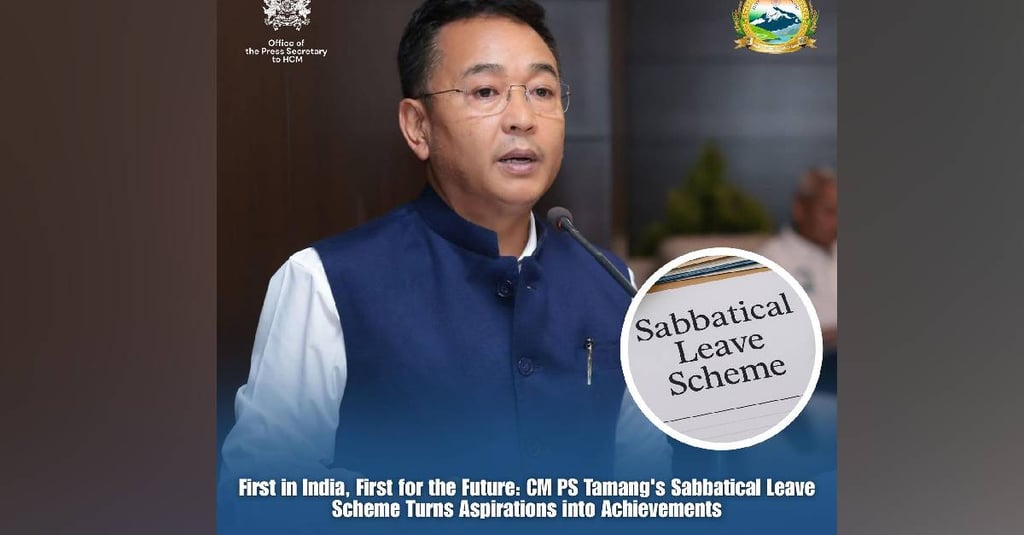Sikkim sets a national benchmark with India’s first Sabbatical Leave Scheme for government employees
Applications from Group C and D employees must go through their respective HoDs, and Group A and B officers must obtain clearance from the Department of Personnel.
LOCAL


In a landmark step that has brought nationwide attention to Sikkim, the state has become the first in India to officially introduce a Sabbatical Leave Scheme for its government employees — a move that is being hailed as a powerful and practical way to support professional growth, personal development, and innovation among the youth.
Introduced in August 2023 through a notification from the Department of Personnel, the scheme allows regular government employees who have completed five years of continuous service to take leave for up to three years (1,080 days), during which they receive 50% of their basic pay. Most importantly, their seniority remains protected, and their jobs stay secure. The government retains the right to recall the employee with a month’s notice if needed.
In a progressive move, the scheme was later extended to temporary employees as well. Those who have served at least six months continuously in temporary roles are now eligible under the same terms. These developments reflect the Sikkim Government’s efforts to build a more flexible and compassionate administrative system.
To further simplify and decentralise the process, the Government of Sikkim delegated approval powers in April 2025. Heads of Departments (HoDs) can now directly approve leave applications from Group C and D employees, including temporary staff, while Group A and B officers must still obtain clearance from the Department of Personnel.
The policy is more than just a leave option — it has turned into a life-changing opportunity for many. One such example is Archana Bhattarai, a Commercial Tax Inspector in the Finance Department, who took her sabbatical in August 2024 to complete her Chartered Accountancy (CA) final exams — a long-pending dream. “The Sabbatical Leave policy empowered me to complete my CA qualification while retaining my government position. I thank the Hon’ble Chief Minister for introducing such a visionary scheme that truly supports the aspirations of working professionals in Sikkim,” Archana said.
Another inspiring case is that of Ashwin, an Assistant Engineer in the state government, who used his sabbatical to build an EdTech startup. In just a year, his startup generated ₹45 lakh in revenue and provided employment to eight local youths. His startup was also selected for DigiSapne 2.0, a Ministry of IT initiative in partnership with AIC-SMU TBI. "This scheme gives us the freedom to explore ambitious goals while safeguarding our service and seniority," he said. “I am deeply grateful to our Hon’ble Chief Minister for this empowering policy.”
Arpan Gurung, a Graduate Teacher (Mathematics) at K.B. Limboo Senior Secondary School in Sribadam, took sabbatical leave in June 2025 to pursue sustainable agriculture. He started Hasyam Farms, a Rainbow Trout venture, and launched a large-scale Dalle Khursani (fireball chili) farming initiative. Today, he leads a group of 87 fish farmers with support from the Department of Fisheries. “I’m still a maths teacher, just at a fish and pepper farm now,” he says with a smile. “Thank you, Hon’ble Chief Minister sir, for your visionary leadership and support.”
These personal accounts show how the Sabbatical Leave policy is not just a rule on paper but a genuine tool for personal transformation. It encourages public servants to pursue education, business, or social work, while also retaining job security.
While the scheme is wide-reaching, it comes with well-defined guidelines. Applications from Group C and D employees must go through their respective HoDs, and Group A and B officers must obtain clearance from the Department of Personnel. However, due to the critical nature of their work, personnel in the Sikkim Police, Armed Police, State Jail Police, Indian Reserve Battalion, and health professionals like doctors and nurses, are not eligible for this scheme at present. These restrictions ensure that essential public services remain uninterrupted.
The Sabbatical Leave Scheme reflects Chief Minister Prem Singh Tamang’s deep belief in people-centric governance. By trusting government employees with the freedom to explore academic, entrepreneurial, and social avenues, he has shown that human development can go hand in hand with good governance.
This policy is also closely aligned with the Chief Minister’s wider vision seen in initiatives like ‘One Family, One Entrepreneur’, which aim to create a self-reliant ecosystem in Sikkim. Together, these reforms are helping to build a new generation of confident, skilled, and self-driven youth in the state.
